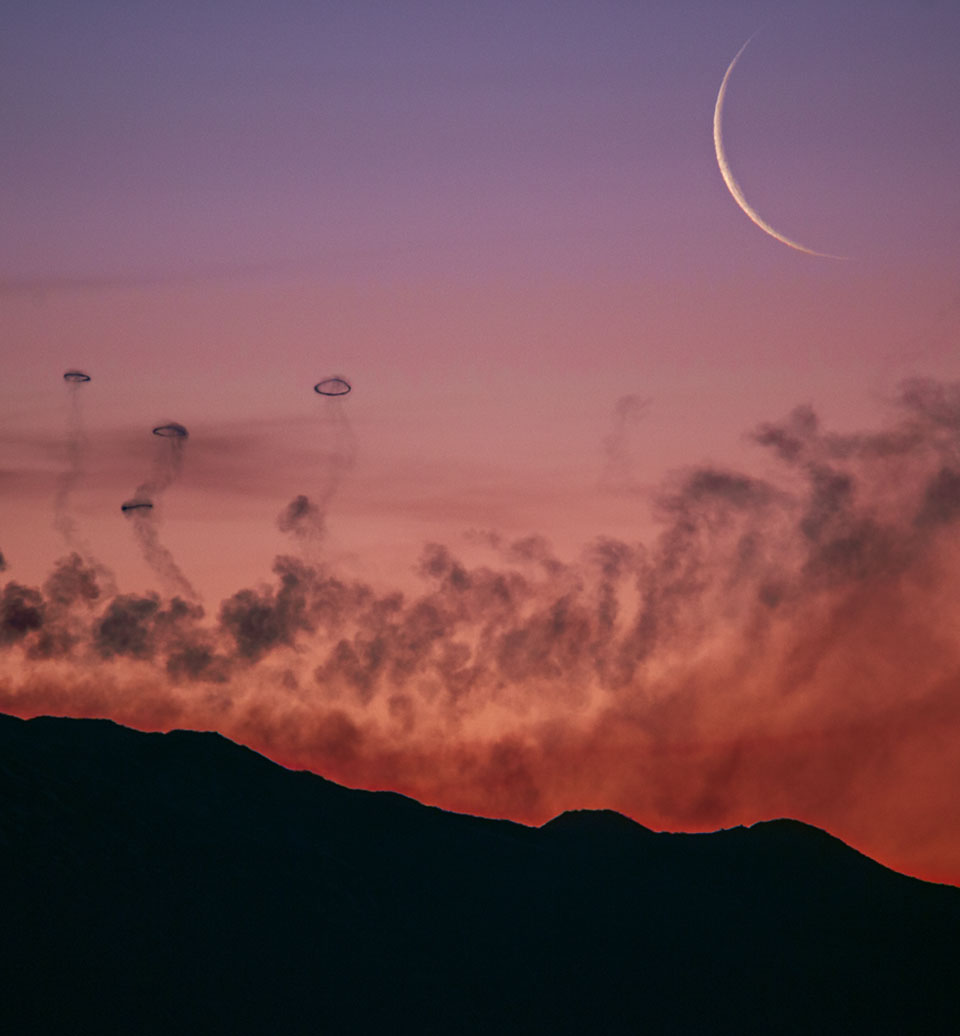Nombre total de pages vues
23/04/2024
ASTRONOMIE - Survolez un magnifique lac de lave de 200 km de diamètre sur la lune volcanique Io !
SANTé/MEDECINE - HISTOIRE - 1980 : invention de l'IRM
SANTé/MEDECINE - Les avancées contre le cancer
ASTRONOMY - Contrail Shadow X
2024 April 23
Image Credit & Copyright: Fatih Ekmen
Explanation: What created this giant X in the clouds? It was the shadow of contrails illuminated from below. When airplanes fly, humid engine exhaust may form water droplets that might freeze in Earth's cold upper atmosphere. These persistent streams of water and ice scatter light from the Sun above and so appear bright from below. On rare occasions, though, when the Sun is near the horizon, contrails can be lit from below. These contrails cast long shadows upwards, shadows that usually go unseen unless there is a high cloud deck. But that was just the case over Istanbul, Türkiye, earlier this month. Contrails occur all over planet Earth and, generally, warm the Earth when the trap infrared light but cool the Earth when they efficiently reflect sunlight. The image was taken by a surprised photographer in the morning on the way to work.
22/04/2024
SANTé/MEDECINE - Homme ou animal : qui est le plus fort ? - Vitesse
SANTé/MEDECINE - La compléxité de la tête humaine - Tête vue de côté avec les nerfs trijumeaux
ASTRONOMY - Moon and Smoke Rings from Mt. Etna
Image Credit & Copyright: Dario Giannobile
Explanation: Yes, but can your volcano do this? To the surprise of some, Mt. Etna emits, on occasion, smoke rings. Technically known as vortex rings, the walls of the volcano slightly slow the outside of emitted smoke puffs, causing the inside gas to move faster. A circle of low pressure develops so that the emitted puff of volcanic gas and ash loops around in a ring, a familiar geometric structure that can be surprisingly stable as it rises. Smoke rings are quite rare and need a coincidence of the right geometry of the vent, the right speed of ejected smoke, and the relative calmness of the outside atmosphere. In the featured image taken about two weeks ago from Gangi, Sicily, Italy, multiple volcanic smoke rings are visible. The scene is shaded by the red light of a dawn Sun, while a crescent Moon is visible in the background.
21/04/2024
SANTé/MEDECINE - La compléxité de la tête humaine - Angiographie de l’artère carotide
ASTRONOMY - Perijove 16: Passing Jupiter
2024 April 21
Video Credit & License: NASA, Juno, SwRI, MSSS, Gerald Eichstadt;
Music: The Planets, IV. Jupiter (Gustav Holst); USAF Heritage of America Band (via Wikipedia)
Explanation: Watch Juno zoom past Jupiter. NASA's robotic spacecraft Juno is continuing on its now month-long, highly-elongated orbits around our Solar System's largest planet. The featured video is from perijove 16, the sixteenth time that Juno passed near Jupiter since it arrived in mid-2016. Each perijove passes near a slightly different part of Jupiter's cloud tops. This color-enhanced video has been digitally composed from 21 JunoCam still images, resulting in a 125-fold time-lapse. The video begins with Jupiter rising as Juno approaches from the north. As Juno reaches its closest view -- from about 3,500 kilometers over Jupiter's cloud tops -- the spacecraft captures the great planet in tremendous detail. Juno passes light zones and dark belts of clouds that circle the planet, as well as numerous swirling circular storms, many of which are larger than hurricanes on Earth. As Juno moves away, the remarkable dolphin-shaped cloud is visible. After the perijove, Jupiter recedes into the distance, now displaying the unusual clouds that appear over Jupiter's south. To get desired science data, Juno swoops so close to Jupiter that its instruments are exposed to very high levels of radiation.
20/04/2024
SANTé/MEDECINE - Homme ou animal : qui est le plus fort ? - Le cerveau
SANTé/MEDECINE - CANCER - 12 AVANCEES REVOLUTIONNAIRES - 7. Des biopsies liquides et synthétiques moins invasives et plus rapides
Les biopsies classiques nécessitent le prélèvement de tissu, souvent par chirurgie. Aujourd’hui, la biopsie liquide offre une alternative pl...

-
2022 September 26 All the Water on Planet Earth Illustration Credit: Jack Cook, Adam Nieman, Woods Hole Oceanographic Institution ; Data ...
-
2025 May 11 The Surface of Venus from Venera 14 Image Credit: Soviet Planetary Exploration Program , Venera 14 ; Processing & Copyri...








